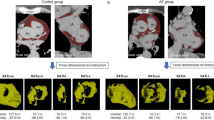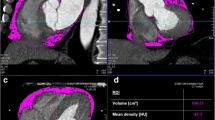Abstract
Purpose
Epicardial adipose tissue (EAT) surrounding the left atrium has been reported to have a pro-arrhythmic influence on atrial myocardium and to play an important role in the pathophysiology of atrial fibrillation (AF). The purpose of this study was to explore whether the abundance of EAT correlates with early and late recurrences of AF after ablation.
Methods
We included 53 consecutive patients with drug-refractory AF scheduled for ablation. Early and late recurrences were defined as atrial tachyarrhythmias within and after 3 months following the ablation procedure, respectively. The total and left atrial EAT volumes were obtained by 320-detector-row multislice computed tomography.
Results
During a follow-up period of 16 ± 4 months, early and late recurrences occurred in 29 (55 %) and 12 (23 %) patients, respectively. The left atrial EAT volume was larger in patients with than without early recurrence (35.1 ± 13.1 vs. 25.0 ± 9.5 cm3, p = 0.002); however, there was no difference in the total EAT volume between the two groups (98.5 ± 45.7 vs. 94.5 ± 35.2 cm3, p = 0.72). A multivariate analysis revealed that a large left atrial EAT volume, persistent AF, and large left atrial volume were independent predictors of early recurrence. Conversely, there was no significant difference in left atrial (29.3 ± 14.6 vs. 29.7 ± 11.7 cm3, p = 0.93) and total EAT (91.0 ± 50.1 vs. 97.9 ± 37.0 cm3, p = 0.66) volumes between patients with and without late recurrence.
Conclusions
The abundance of left atrial EAT independently predicted early recurrence after AF ablation; on the contrary, it did not have an impact on late recurrence. Left atrial EAT may have a pro-arrhythmic influence, especially in the early post-ablation phase.




Similar content being viewed by others
References
Mazurek, T., Zhang, L., Zalewski, A., Mannion, J. D., Diehl, J. T., Arafat, H., Sarov-Blat, L., et al. (2003). Human epicardial adipose tissue is a source of inflammatory mediators. Circulation, 108, 2460–2466.
Taguchi, R., Takasu, J., Itani, Y., Yamamoto, R., Yokoyama, K., Watanabe, S., & Masuda, Y. (2001). Pericardial fat accumulation in men as a risk factor for coronary artery disease. Atherosclerosis, 157, 203–209.
Thanassoulis, G., Massaro, J. M., O’Donnell, C. J., Hoffmann, U., Levy, D., Ellinor, P. T., Wang, T. J., et al. (2010). Pericardial fat is associated with prevalent atrial fibrillation: the Framingham Heart Study. Circulation. Arrhythmia and Electrophysiology, 3, 345–350.
Venteclef, N., Guglielmi, V., Balse, E., Gaborit, B., Cotillard, A., Atassi, F., & Amour, J., et al. (2013). Human epicardial adipose tissue induces fibrosis of the atrial myocardium through the secretion of adipo-fibrokines. European Heart of Journal. 22.
Tsao, H. M., Hu, W. C., Wu, M. H., Tai, C. T., Lin, Y. J., Chang, S. L., Lo, L. W., et al. (2011). Quantitative analysis of quantity and distribution of epicardial adipose tissue surrounding the left atrium in patients with atrial fibrillation and effect of recurrence after ablation. American Journal of Cardiology, 107, 1498–1503.
Oral, H., Knight, B. P., Ozaydin, M., Tada, H., Chugh, A., Hassan, S., Scharf, C., et al. (2002). Clinical significance of early recurrences of atrial fibrillation after pulmonary vein isolation. Journal of the American College of Cardiology, 40, 100–104.
Pappone, C., Manguso, F., Vicedomini, G., Gugliotta, F., Santinelli, O., Ferro, A., Gulletta, S., et al. (2004). Prevention of iatrogenic atrial tachycardia after ablation of atrial fibrillation: a prospective randomized study comparing circumferential pulmonary vein ablation with a modified approach. Circulation, 110, 3036–3042.
Lee, S. H., Tai, C. T., Hsieh, M. H., Tsai, C. F., Lin, Y. K., Tsao, H. M., Yu, W. C., et al. (2004). Predictors of early and late recurrence of atrial fibrillation after catheter ablation of paroxysmal atrial fibrillation. Journal of Interventional Cardiac Electrophysiology, 10, 221–226.
Koyama, T., Sekiguchi, Y., Tada, H., Arimoto, T., Yamasaki, H., Kuroki, K., Machino, T., et al. (2009). Comparison of characteristics and significance of immediate versus early versus no recurrence of atrial fibrillation after catheter ablation. American Journal of Cardiology, 103, 1249–1254.
Chang, S. L., Tsao, H. M., Lin, Y. J., Lo, L. W., Hu, Y. F., Tuan, T. C., Suenari, K., et al. (2011). Characteristics and significance of very early recurrence of atrial fibrillation after catheter ablation. Journal of Cardiovascular Electrophysiology, 22, 1193–1198.
Chang, S. L., Tai, C. T., Lin, Y. J., Wongcharoen, W., Lo, L. W., Tuan, T. C., Udyavar, A. R., et al. (2007). Biatrial substrate properties in patients with atrial fibrillation. Journal of Cardiovascular Electrophysiology, 18, 1134–1139.
Verma, A., Wazni, O. M., Marrouche, N. F., Martin, D. O., Kilicaslan, F., Minor, S., Schweikert, R. A., et al. (2005). Pre-existent left atrial scarring in patients undergoing pulmonary vein antrum isolation: an independent predictor of procedural failure. Journal of the American College of Cardiology, 45, 285–292.
Chang, S. L., Tai, C. T., Lin, Y. J., Wongcharoen, W., Lo, L. W., Tuan, T. C., Udyavar, A. R., et al. (2007). The efficacy of inducibility and circumferential ablation with pulmonary vein isolation in patients with paroxysmal atrial fibrillation. Journal of Cardiovascular Electrophysiology, 18, 607–611.
Chao, T. F., Hung, C. L., Tsao, H. M., Lin, Y. J., Yun, C. H., Lai, Y. H., Chang, S. L., et al. (2013). Epicardial adipose tissue thickness and ablation outcome of atrial fibrillation. PLoS One, 8, e74926.
Author information
Authors and Affiliations
Corresponding author
Rights and permissions
About this article
Cite this article
Masuda, M., Mizuno, H., Enchi, Y. et al. Abundant epicardial adipose tissue surrounding the left atrium predicts early rather than late recurrence of atrial fibrillation after catheter ablation. J Interv Card Electrophysiol 44, 31–37 (2015). https://doi.org/10.1007/s10840-015-0031-3
Received:
Accepted:
Published:
Issue Date:
DOI: https://doi.org/10.1007/s10840-015-0031-3




